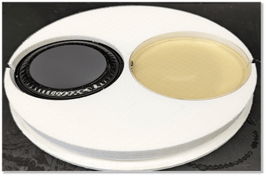blog
November 24, 2023 | Source: Rapid Micro Biosystems, Inc.
Automating Your Passive Air Monitoring
POSTED BY Rapid Micro Biosystems | 7 minute read
November 24, 2023 | Source: Rapid Micro Biosystems, Inc.
POSTED BY Rapid Micro Biosystems | 7 minute read
Recent Annex 1 updates have opened the door to rapid methods in passive air monitoring. But is the way blocked by that iconic symbol of microbiology, the petri dish? Research by Rapid Micro Biosystems now provides fresh insights on how traditional settle plate testing can be automated with the Growth Direct® System, while detailing the impact of plate size on microbial recovery.
Bacteria, fungi, and viruses can all originate from people or environmental sources within pharma facilities, dictating active and passive air sampling to evaluate potential contaminants. Traditionally, passive air monitoring strategies have assessed the risk of harmful microorganisms falling onto critical surfaces by using 90mm petri dishes with culture media as “settle plates.”
Not surprisingly, plate surface area has an impact on recovery rates during passive air studies. When you’re measuring the number of microorganisms settling from air onto a known surface area over a known time period, a bigger surface should help you recover more. Small wonder, then, that the traditional settle plate method is still endorsed by Annex 1 guidelines as good manufacturing practice (GMP) in Europe.
It’s important to note that Annex 1 also allows end-users the option of utilizing other qualified methods. In fact, the guidelines strongly encourage deployment of rapid methods such as the Growth Direct® System. If you’re a pharma manufacturer striving to remain competitive, automation has real advantages – elimination of the manual reading cycle, improved data integrity, and the efficiencies of a single consumable that can be used for both settle plate and surface sampling in your environmental monitoring program.
Establishing the feasibility of an alternative method, however, is complicated by differences in settle plate surface area.
The Growth Direct® Cassette for environmental monitoring is the same size as a RODAC or contact plate, designed with specific mechanical and optical features that support automated handling and imaging in order to achieve rapid microbial enumeration. It incorporates standard media such as TSA-LP80 or TSA-LP80HT, with a black 0.45-micron pore-sized cellulose ester membrane covering the media surface.
By way of comparison, a traditional 90mm petri plate has a surface area 2.5 times greater than a Growth Direct® Cassette. For firms considering a switch to the Growth Direct® System, the difference in surface area can raise important equivalency questions:
To address such questions with hard data, Rapid Micro Biosystems recently collaborated with researchers from Rutgers University. Results were presented in October 2023 at the annual Parenteral Drug Association (PDA) Pharmaceutical Microbiology Conference.
By simulating bioaerosol particle deposition in vitro, researchers conducted passive air studies of microbial recovery with a 90mm petri plate. They then applied the same approach to generate results using either one or two of our proprietary Growth Direct® Cassettes. An identical TSA LP80 growth media formulation was used in each instance, with at least 30 replicates of each test setup exposed to the challenge microorganism over a period of 4 hours.

Passive air studies compared microbial recovery with a traditional 90mm petri plate to setups featuring either one or two Growth Direct® Cassettes.
A key finding was that test setups featuring two Growth Direct® Cassettes demonstrated microbial recovery rates ≥80% of those for a single 90mm petri plate – meeting typical alternative microbial validation guidelines for equivalence.
“The data strongly supports the feasibility of using two Growth Direct® Cassettes in place of a single petri plate as an alternative settle plate method,” notes RMB Applications Product Manager Eric Chenelle, one of the study’s co-authors. “With the true value of passive air testing being trending analysis and not any one single test, users considering automation have a choice of plate sizes, provided they use one consistently.”
The key word, of course, is choice. Users of the dual-cassette option can transition directly away from the standard 90mm petri plate without any sort of correction factor, but the change in footprint will impact method validation. Alternatively, single-cassette use would require a correction factor for equivalence with a 90mm petri dish but can be readily used in the existing validated locations for simplified adoption.
At every step, our proven validation support team at Rapid Micro Biosystems has the resources to help you explore your options and make a strong business case for automated microbial enumeration. Because the Growth Direct® System is used by a majority of the world’s Top 20 pharma companies, technical experts are available with answers to all your process or regulatory questions. Just contact us today.